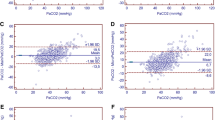Abstract
Objective. To assess the correlation and accuracy of end-tidal PCO2 (PetCO2) sampled via nasal cannulae in pediatric patients by comparison to the criterion standard PaCO2, and to identify sources of error during PetCO2 monitoring via nasal cannulae.Methods. PetCO2 was monitored continuously by sampling end-tidal gas through nasal cannulae that had been designed and manufactured for this purpose in spontaneously breathing children undergoing conscious or deep sedation during either cardiac catheterization (n = 43) or critical care (n = 54). When both the capnographic wave form and the PetCO2 value had been stable for at least 10 minutes, the PetCO2 value was recorded while blood was drawn from an indwelling arterial line for PaCO2 measurement. The effects of age, weight, respiratory rate, oxygen delivery system, airway obstruction, mouth breathing, and cyanotic heart disease were evaluated by linear regression analysis and calculation of absolute bias (PaCO2-PetCO2).Results. Mouth breathing, airway obstruction, oxygen delivery through the ipsilateral nasal cannula, and cyanotic heart disease adversely affected accuracy. In patients without those factors, PetCO2 correlated well with PaCO2 (R2 = 0.994), and absolute bias was 3.0 ± 1.8 mmHg.Conclusions. Several factors — some controllable and all recognizable — affect the accuracy of PetCO2 monitored via nasal cannulae in pediatric patients. When these factors are not present, PetCO2 correlates well with PaCO2 and appears to be a useful monitor of ventilatory status during conscious or deep sedation.
Similar content being viewed by others
References
Bailey PL, Pace NL, Ashburn MA, Moll JWB, East KA, Stanley TH. Frequent hypoxemia and apnea after sedation with midazolam and fentanyl. Anesthesiology 1990; 73: 826–830
Wright SW. Conscious sedation in the emergency department: The value of capnography and pulse oximetry. Ann Emerg Med 1992; 21: 551–555
Friesen RH, Aslwang M. Changes in carbon dioxide tension and oxygen saturation during deep sedation for paediatric cardiac catheterization. Paediatr Anaesth 1996; 6: 15–20
Wilson JE, Pendleton JM. Oligoanalgesia in the emergency department. Am J Emerg Med 1989; 7: 620–623
Goldman JM. A simple, easy, and inexpensive method for monitoring ETCO2 through nasal cannulae. Anesthesiology 1987; 67: 606
Bowe EA, Boysen PG, Broome JA, Klein EF Jr. Accurate determination of end-tidal carbon dioxide during administration of oxygen by nasal cannulae. J Clin Monit 1989; 5:105–110
Ackerman WE, Phero JC, Reaume D. End tidal carbon dioxide and respiratory rate measurement during conscious sedation through a nasal cannulae. Anesth Prog 1990; 37: 199–200
Hunter JA. A cost-free, simple method for monitoring end tidal carbon dioxide through nasal cannulae. Anesth Prog 1990; 37: 301–303
Roy J, McNulty SE, Torjman MC. An improved nasal prong apparatus for end-tidal carbon dioxide monitoring in awake, sedated patients. J Clin Monit 1991; 7: 249–252
McNulty SE, Roy J, Torjman M. Relationship between arterial carbon dioxide and end-tidal carbon dioxide when a nasal sampling port is used. J Clin Monit 1990; 6: 93–98
Tobias JD, Flanagan JFK, Wheeler TJ, Garrett JS, Burney C. Noninvasive monitoring of end-tidal CO2 via nasal cannulas in spontaneously breathing children during the perioperative period. Crit Care Med 1994; 22: 1805–1808
Lindahl SGE, Yates AP, Hatch DJ. Relationship between invasive and noninvasive measurements of gas exchange in anesthetized infants and children. Anesthesiology 1987; 66: 168–175
Sivan Y, Eldadah MK, Cheah T, Newth CJL. Estimation of arterial carbon dioxide by end-tidal and transcutaneous PCO2 measurements in ventilated children. Pediatr Pulmonol 1992; 12:153–157
Sasse FJ. Can we trust end-tidal carbon dioxide measurements in infants? J Clin Monit 1985; 1: 147–148
Badgwell MJ, McLeod ME, Lerman J, Creighton RE. End-tidal PCO2 measurements sampled at the distal and proximal ends of the endotracheal tube in infants and children. Anesth Analg 1987; 66: 959–964
Gravenstein N, Lampotang S, Beneken JEW Factors influencing capnography in the Bain circuit. J Clin Monit 1985; 1: 6–10
Schieber RA, Namnoum A, Sugden A, Saville AL, Orr RA. Accuracy of expiratory carbon dixide measurements using the coaxial and circle breathing circuits in small subjects. J Clin Monit 1985; 1: 149–155
Raemer DB, Calalang I. Accuracy of end-tidal carbon dioxide tension analyzers. J Clin Monit 1991; 7:195–208
Westenskow DR, Coleman DL. Can the Raman scattering analyzer compete with mass spectrometers: An affirmative reply. J Clin Monit 1989; 5: 34–36
Author information
Authors and Affiliations
Rights and permissions
About this article
Cite this article
Friesen, R.H., Alswang, M. End-tidal PCO2 monitoring via nasal cannulae in pediatric patients: Accuracy and sources of error. J Clin Monitor Comput 12, 155–159 (1996). https://doi.org/10.1007/BF02078136
Received:
Accepted:
Issue Date:
DOI: https://doi.org/10.1007/BF02078136




